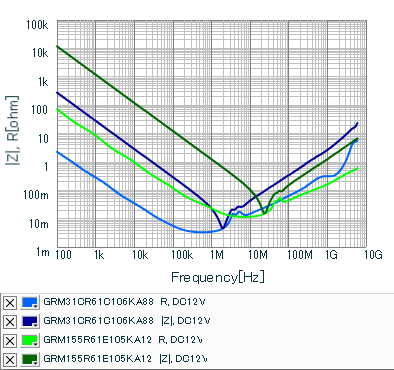Dc voltage for select 4 7µf capacitors.
Ceramic capacitance vs temperature.
The second character indicates the maximum temperature.
5 as in x5r corresponds to 85 c and 7 as in x7r corresponds to 125 c.
The third character indicates the maximum amount of capacitance change over the part s temperature range.
The spec for r capacitors such as x5r and x7r is 15.
The typical temperature range for ceramic capacitors is 40 to 85 c or 125 c where their capacitance varies about from 5 to 40 having a sweet spot around 5 to 25 c.
That is to say these are c0g characteristics products with a small temperature variance width.
Capacitors ceramic capacitors multilayer ceramic chip capacitors.
This is a mechanism of decrease in the capacitance after applying dc voltage.
Ceramic capacitors are brittle and sensitive to thermal shock so precautions need to be taken to avoid cracking during mounting especially for high capacitance large sizes.
For your information in temperature compensation capacitors ch c0g characteristics etc capacitance doesn t change because paraelectric ceramic is used as its main material and that gives the dc voltage characteristic to the capacitors.
C0g and np0 class 1 ceramic temperature characteristics do not show significant changes in capacitance vs temperature.
Temperature compensating type multilayer ceramic capacitors have a small temperature coefficient of electrostatic capacitance max.
Figure 5 illustrates the typical capacitance response over temperature for tantalum capacitors class 2 ceramic x7r capacitors and class 1 ceramic np0 or c0g capacitors.
1 y5u capacitance change vs temperature 2 dc voltage d c volt temperature compensating mlcc 1 capacitance change vs temperature 2 frequency mhz 3 dc voltage d c volt note.
Ceramic capacitor temperature response.
5 capacitance change at 55.
Generally heat lowers class 2 capacitors capacitances however around the curie point approximately 120 c for batio3 the capacitance increases.
The tantalum capacitor exhibits linear capacitance change with respect to temperature.
The theoretical range is from 45 c to 200 c.
30 ppm c 25 c reference within the temperature range of 55 c to 125 c.
For more detail and update please visit our website.
Note first that as the package size increases the capacitance variation with applied dc voltage decreases and substantially.
A second interesting point is that within a package size and ceramic type the voltage rating of the capacitors seems often to have no effect.

